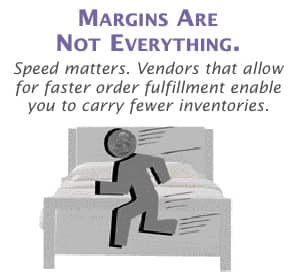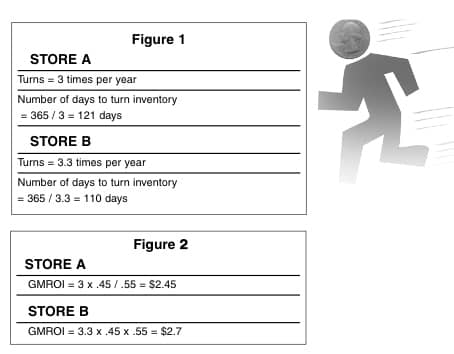To increase GM, many people automatically think of increasing price or not selling at discounts. And, to decrease inventory on hand, clearance sales or sweeping discounts are a favorite. Unfortunately, these are counter productive strategies, as gross margins are offset. Clearance sales may have there time and place, however, there are many other more productive ways to increase GMROI, and you can do it without increasing prices or holding inventory clearance sales.

Let’s look at an alternative GMROI formula: GMROI = Turns x (Gross margin % / Cost of goods %)
In this formula, Gross Margin Percentage equals 100 x (1 - cost of goods sold/ net sales) = 100 x (gross margin/ net sales).
Knowing this will allow your creative juices to flow more freely. And so can your merchandise! The secret is that by flowing your inventory faster (higher turns), you can obtain a much higher GMROI. So what’s it worth?
Let’s look at the two examples in Figures 1 and 2 on the following page, and keep GMROI constant at 45%.
What’s the Difference? In Figure 1, store B turns inventory 11 days faster than Store A. So, .3 more turns a year equates to 11 days. Doesn’t seem like much, right?
Now, let’s look at the GMROI impact of flowing inventory 11 days faster in Figure 2.
What’s the Difference? In Figure 2, store B makes .25 cents more for every dollar it invests in inventory than store A. So, what’s that value of a quarter? It’s MASSIVE!!!
At a $1 million in inventory, 25 cents in GMROI is equal to $250,000 in gross margin produced!
Using the traditional GMROI formula of GM $ / Inventory $, and holding inventory constant, some simple algebra shows us that the increase in GM $ is the GMROI Increase x Inventory value
GM $ Increase = 25 cents x $1 million = $ 250,000.
Where else can you find $250,000 lying around?
Do you think it is worth it to try to improve your inventory flow efficiency so you can turn your merchandise 11 days faster? Of course it is!

Ways to get your 11 days and the extra $250,000
Quick Ship: Margins are not everything. Speed matters. Vendors that allow for faster order fulfillment permit retailers to carry less inventory. The best example of this I’ve seen is an Australian retailer who can deliver custom, high end sofas to customers within a week.
Fast Receiving: Don’t let merchandise sit on your dock un-received in your system. Use the latest technology to get it counted into your inventory. The fastest operations are receiving via wireless scanners as merchandise is unloaded. This creates a culture of zero delay within a business.
Speedy Delivery Scheduling: Implement systems that show what merchandise can be scheduled, so you can book delivery times with customers as fast as possible. You should work towards having a high majority of your completed sales scheduled.
Routing and Mapping Automation for More Efficient Delivery: Use automated systems to schedule faster, fill trucks easier, and take the best routing. The benefits are faster customer delivery and significantly reduced costs.
Improve Customer Pick-up’s: As with deliveries, contact customers ASAP to set a time for them to pick up their merchandise. Companies that do this are seen as being more professional, saving their customers and themselves time.
Display all Merchandise – FAST: This is an area where many stores can use improvement. How can you sell something if you do not display it? Build a process similar to this:
- Create a printout of all available merchandise that is in your warehouse but is not on display (every day).
- Create transfer orders.
- Physically check merchandise and determine the best price points.
- Put new merchandise in high traffic floor slots to properly test their value with your customers.
Efficient Customer Service: The return and repair process in the best companies is systematized so that it is a quick process for both stores and customers. You should know exactly how many customer service issues are outstanding, what needs to be repaired, and what needs to be replaced. You do not want damaged or opened merchandise choking your profits. One of my best clients runs daily reports and takes actions to minimize dead inventory, thus increasing turns. He estimates this alone saves him over $50,000 per year.
Best Seller Recognition: Great managers track winning merchandise and respective rates of sale, so that they can reorder at the right time and in the appropriate quantity. Have this proven product available for your customer using a JIT (just-in-time), not JIC (just-in-case), inventory dramatically increases turns. How? By increasing sales, decreasing lead time and minimizing inventory.
Burn Your Dogs: “If it doesn’t sell in 60 days, take it out to the front lawn and BURN IT!” This advice is from an exemplary retailer who gets $3 GMROI and over $400 sales per square foot. Translation: Use a markdown aging strategy that turns inventory quickly.
Buy New Merchandise - At the Right Time: Create an “open to buy” that acts as your stoplight when bringing on new items. Red is when you are over inventoried, yellow is on the edge, and green is when you are at an efficient GMROI (over $2), or Inventory to Sales (Under 20%). Best practice businesses use these metrics to determine their new purchasing actions.
Get Your People Up To Speed as Industry Professionals: Just like you get a lawyer to handle your legal issues and an accountant to handle your taxes, get an industry expert to help your people implement procedures that yield a fast GMROI. Productive and motivated people that produce the highest, are the key.
So there you have it: 11 ways that can help you turn your inventory 11 days faster and maximize GMROI. Implement these ideas and you can make an extra $250,000 in GM per million in inventory invested.
David McMahon is a Business Coach for PROFITconsulting. PROFITsystems delivers a "Total Success System" through PROFIT professional, PROFITconsulting, PROFITgroups, PROFITuniversity,
PROFITfreight, and PROFITservices. These business units offer best-practice solutions designed to maximize cash flow and profitability. Questions about this article or related topics can be sent to David care of FURNITURE WORLD Magazine at davidm@furninfo.com.